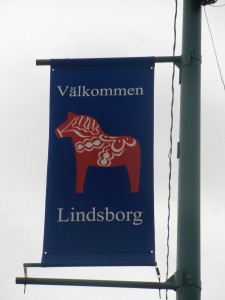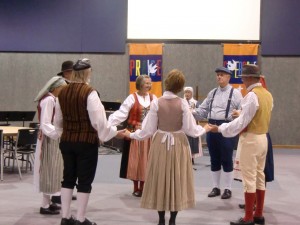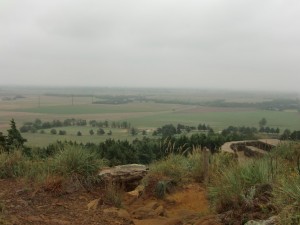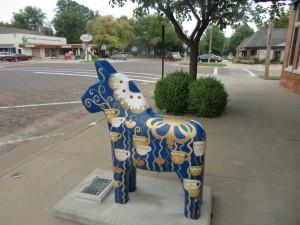ROAMING AROUND KANSAS – A TOUCH OF SWEDEN ON THE PLAINS
ROAMING AROUND KANSAS
This is the fifth in a series of articles about touring the state of Kansas
A TOUCH OF SWEDEN ON THE PLAINS
By Charles N. Stevens
Photos by Dolores Seidman
The thunderstorms promised during the night never materialized, the blinding eye of the sun breaking over the plains, already warming the morning.
By 9a.m. our bus rolls onto the almost empty Interstate 70. We pass through typical Kansas scenery, the land somewhat flat this morning with alternating crops, small patches of forest and swaths of bright yellow sunflowers. Now and then we come upon towering grain elevators, clusters of them resembling city skyscrapers. After a turn on I-135 and then state highway 4, again passing vast fields of sunflowers, we arrive at Lindsborg, a town founded by Swedish Lutherans in 1869. On almost every corner, painted in different colors and designs, stands a plastic Swedish horse, a symbol of Sweden. A perky young woman dressed in a folk costume enters our bus, welcomes us to the town and directs us to a small café across the street to wait for a tour. We understand there are two such cafes in town, one for Republicans and one for Democrats, keeping them from arguing with each other. While in our café we talk to a doctor who had lived in Lindsborg for over forty years and loves it. The clear sky of dawn quickly fills with clouds.
Back on the bus again, our guide directs us to the Bethany Lutheran Church with its snow white exterior and steep roofs. The inside of the church is also white with red carpeting and polished wooden pews. While the church secretary gives us a history of the church, I look up into the vast rounded ceiling and the great silver tubes of the organ. A retired music teacher from Bethany College entertains us with an organ concert, his gray head looking small against the great tubes, the rich tones reverberating through the sanctuary.
We drive by the brick buildings of Bethany College, a small liberal arts college founded by Swedish Lutheran immigrants in 1881. It is now affiliated with the Evangelical Lutheran Church of America. Its athletic teams are known as the “Terrible Swedes.”
Driving on the Trinity United Methodist Church, the local people treat us to a Swedish buffet lunch. We can select from pickled herring, cheese, bread, pickled cucumber with dill, green bean casserole, Swedish potatoes with dill and meatballs followed by a pudding with lingonberries and whipped cream. As we dine on the delicacies, an elderly woman plays the violin while several townspeople, including the doctor that we had met earlier, perform Swedish folk dances. The festivities give us the flavor of the town. When we leave the church we are met with a cold drizzle.
Soon we are on our way again with our guide, this time several miles out of town to a place called Coronado Heights, a single hill that rises up out of the flat plains. Our bus negotiates the rough road that winds up to the top of the hill where a stone “castle “ had been built, some say by the WPA during the Great Depression. Yellow wild flowers dance in the wind as we walk out on the misty hill top and amble around in the castle, its halls dark, cold and windy. Its outer stones are splotched with greenish yellow lichen. All in all, the castle is rather spooky. From this height we can see miles and miles of farmland around us. There is a chance that Coronado came through here on his expedition of 1540-1542 looking for the golden city of Cibola, thus the name of the hill, but no one knows if that is historically accurate. We are told that when the weather is nice, people drive up here to toast the sunset with a glass of wine.
Our next stop is the Old Mill Museum then the outdoor museum across the street where many of the old but historic buildings have been moved. Walking through it is like visiting a town of the 1800s or gazing at a movie set. An ancient, rusting steam locomotive stands cold and silent on a short strip of track by a once busy station.
Downtown again, we get closer looks at the Swedish horses, called Dala Horses. While we wander through the 3-blocks of downtown, we happen on a photographic studio where the proprietor, Jim Richardson, has taken photos that are featured in the National Geographic Magazine, unusual to see in such a small town. The town is not bustling, but there are shops selling many tourist items at high prices. Even though the town was founded by Swedes and still celebrates its Swedishness, there is a Chinese restaurant as well as a Mexican one on the main street.
As we leave Lindsborg under cloudy but dry skies, we’re back on I-135 on our way to McPherson, Kansas where we’ll spend the night at the Holiday Inn Express and dream about everything Swedish.

A banner welcomes us to the Swedish town of Lindsborg, Kansas.

Local Swedish dancers give us the flavor of the old country while we dine on Swedish delicacies.

Coronado Heights rises like a great bump on the Kansas plain. Here, a view from the top.

The Dala wooden horses are famous in Sweden. Large plastic ones are on nearly every corner in Lindsborg.

Different designs decorate the Dala horses on most corners.
MONTEREY PARK AUTHOR PUBLISHES 4th BOOK – Seeking More of the Sky: Growing Up in the 1930’s:
Charles “Norm” Stevens, a 43 year resident of Monterey Park has recently published his 4th book: Seeking More of the Sky: Growing Up in the 1930’s. This is the story of a young boy growing up in Inglewood, California in the l930’s. This was a time during the depression when unemployment was affecting many and the banks were closed, while the clouds of war were gathering in Europe. But he was lucky enough to be raised in a loving family, the power of that love reflected throughout his stories.
Stevens is the author of three previous books about his experiences during WWII:
An Innocent at Polebrook: A Memoir of an 8th Air Force Bombardier (Story of his 34 bombing missions from his base at Polebrook, England over Germany and France)
The Innocent Cadet: Becoming A World War II Bombardier (A prequel to the first, telling of his training in the U.S. before going overseas into combat.)
Back from Combat: A WWII Bombardier Faces His Military Future from Combat: (This book details the time from when he returned from combat in England until the end of the war.)
He is known to the readers of The Citizen’s Voice as the author of Travel Log Articles including “Cruising the Rhine and Mosel”,” Best of the West”, “In Search of Snow” , “From Paris to Normandy on the Seine”, and “Exploring New York”. He is retired, having taught for 32 years, primarily in the Montebello Unified School District.
Those interested in purchasing an autographed copy of any of his books, may contact the author at 323-721-8230 or Normstevens24@gmail.com.



